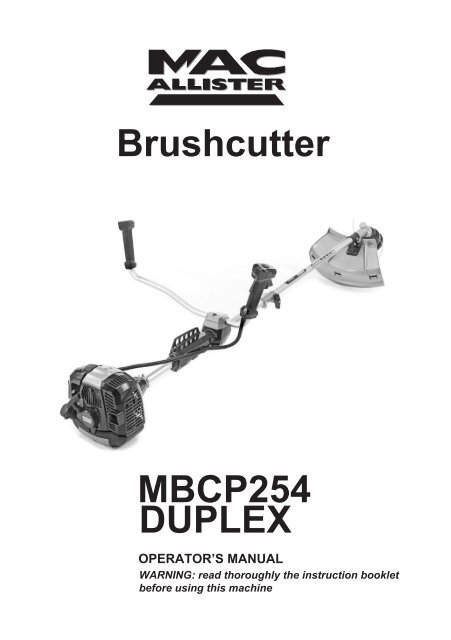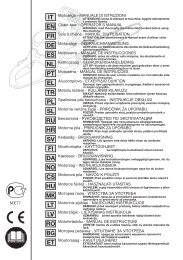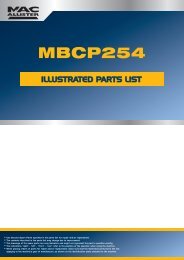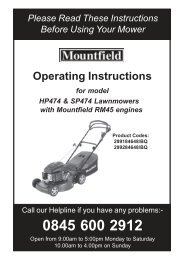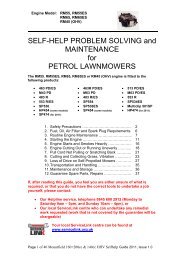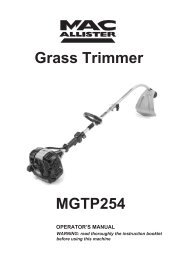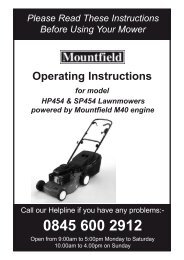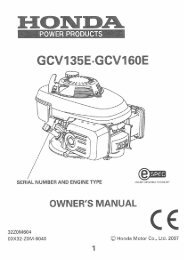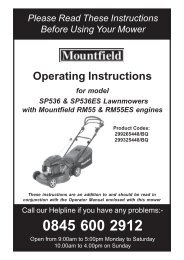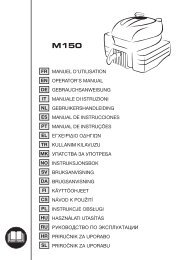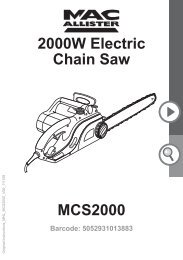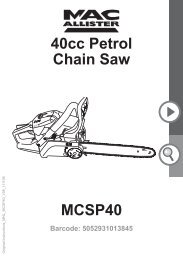MacAllister MBCP254 Brush Cutter - Service Link
MacAllister MBCP254 Brush Cutter - Service Link
MacAllister MBCP254 Brush Cutter - Service Link
Create successful ePaper yourself
Turn your PDF publications into a flip-book with our unique Google optimized e-Paper software.
<strong>Brush</strong>cutter<br />
<strong>MBCP254</strong><br />
DUPLEX<br />
OPERATOR’S MANUAL<br />
WARNING: read thoroughly the instruction booklet<br />
before using this machine
ENGLISH - Original Instructions .................................................................... EN
ii<br />
1 2<br />
2<br />
5<br />
4<br />
1<br />
4<br />
1<br />
2<br />
3<br />
5<br />
7<br />
6<br />
3<br />
7<br />
7<br />
6<br />
4<br />
5 5<br />
4 5<br />
1<br />
1<br />
3<br />
3<br />
2<br />
2<br />
6<br />
2<br />
3<br />
1<br />
4<br />
1<br />
6<br />
4<br />
8<br />
7<br />
5
ii<br />
7<br />
8<br />
STOP<br />
1<br />
3<br />
RUN<br />
2<br />
4<br />
START<br />
3<br />
1<br />
STOP<br />
2<br />
RUN<br />
9<br />
1<br />
5<br />
4<br />
2<br />
START<br />
3<br />
4a<br />
CHOKE<br />
RUN<br />
6<br />
10<br />
11<br />
2.3<br />
1 2.4<br />
2<br />
2.2<br />
2.1<br />
13<br />
14<br />
15
iv<br />
16 17<br />
1<br />
3<br />
2<br />
2<br />
18 19<br />
0,5 mm<br />
1<br />
20 B 21<br />
A<br />
C<br />
1<br />
2<br />
2 x 3,0 m (118 in.)<br />
3<br />
Ø 2,4 mm<br />
30°<br />
30°<br />
5<br />
4<br />
22<br />
2<br />
6<br />
7<br />
120 mm<br />
(4,75 in.)<br />
1<br />
3
INTRODUCTION EN 1<br />
Dear Customer,<br />
thank you for choosing one of our products. We hope that you will be completely satisfied with this machine<br />
and that it fully meets your expectations. This manual has been compiled in order to provide you with all<br />
the information you need to get acquainted with the machine and use it safely and efficiently. Don’t forget<br />
that it is an integral part of the machine, so keep it handy so that it can be consulted when necessary, and<br />
pass it on to a further user if you resell or loan the machine.<br />
Your new machine has been designed and manufactured in pursuance with current regulations, and is safe<br />
and reliable if used in compliance with the instructions provided in this manual (proper use). Using the machine<br />
in any other way, or non-compliance with the safety specifications relative to use, maintenance and<br />
repair is considered "improper use" which will invalidate the warranty, relieve the manufacturer from all liabilities,<br />
and the user will consequently be liable for all and any damage or injury to himself or others.<br />
Since we regular improve our products, you may find slight differences between your machine and the descriptions<br />
contained in this manual. Modifications can be made to the machine without notice and without<br />
the obligation to update the manual, although the essential safety and function characteristics will remain<br />
unaltered. In case of any doubts, please contact your dealer. And now enjoy your work!<br />
TABLE OF CONTENTS<br />
1. Identification of the main components ....................................... 2<br />
2. Symbols ..................................................................................... 3<br />
3. Safety requirements ................................................................... 4<br />
4. Machine assembly ..................................................................... 6<br />
5. Preparing to work ....................................................................... 7<br />
6. How to start - Use - Stop the engine .......................................... 8<br />
7. Using the machine ................................................................... 10<br />
8. Maintenance and storage ........................................................ 12<br />
9. Troubleshooting ....................................................................... 14<br />
10. Technical data ......................................................................... 14<br />
11. Accessories ............................................................................. 16
2 EN<br />
IDENTIFICATION OF MAIN COMPONENTS<br />
1. IDENTIFICATION OF MAIN COMPONENTS<br />
MAIN COMPONENTS<br />
1. Power unit<br />
2. Drive tube<br />
3. Cutting device<br />
a. Blade with 3 points<br />
b. Cutting line head<br />
4. Cutting device guard<br />
5. Front handgrip<br />
6. Guard<br />
7. Handlebar<br />
8. Rear handgrip<br />
9. Connection point<br />
(of the webbing)<br />
10. Identification plate<br />
11. Webbing<br />
a. single belt<br />
b. double belt<br />
12. Angle transmission<br />
13. Blade protection (for transport)<br />
14. Spark plug<br />
11b<br />
11a<br />
“MONO”<br />
21 9<br />
23<br />
22<br />
10<br />
1 “DUPLEX”<br />
14<br />
24<br />
8<br />
1<br />
6 5<br />
22<br />
2 4 12<br />
13<br />
3<br />
3b<br />
3a<br />
21<br />
23<br />
CONTROLS AND FILLING POINTS<br />
21. Engine stop switch<br />
22. Throttle trigger<br />
23. Throttle trigger lockout<br />
24. Starter<br />
25. Choke<br />
26. Primer<br />
31. Fuel tank cap<br />
25<br />
26<br />
31<br />
7<br />
IDENTIFICATION PLATE<br />
10.1) Conformity marking in accordance<br />
with Directive 2006/42/EC<br />
10.2) Name and address of the manufacturer<br />
10.3) Acoustic output level LWA in accordance<br />
with directive 2000/14/EC<br />
10.4) Machine model<br />
10.5) Serial number<br />
10.6) Year of manufacture<br />
10.7) Article Code<br />
10.8) Emission number<br />
10.9) Displacement / Power / RPM<br />
10.10) Cutting width<br />
10.1 10.4 10.2 10.9<br />
10.3<br />
Petrol <strong>Brush</strong>cutter and Grass Trimmer<br />
10.6 10.5 10.10 10.8 10.7
SYMBOLS EN 3<br />
2. SYMBOLS<br />
1 2 3 4<br />
5 6 7 8 9<br />
1) Warning! Danger. The failure to use this machine<br />
correctly can be hazardous for oneself and others.<br />
2) Read the instruction manual before using the<br />
machine.<br />
3) If you are using the machine every day in normal<br />
conditions, you can be exposed to a noise level<br />
of 85 dB (A) or higher. Wear ear protectors,<br />
safety goggles and a protective helmet.<br />
4) Wear gloves and protective footwear!<br />
6) Maximum cutting device speed. Only use suitable<br />
cutting devices.<br />
7) Do not use the circular saw blade. Danger:<br />
Using the circular saw blade with machines<br />
marked with this symbol exposes the user to<br />
the danger of very serious or even fatal injuries.<br />
8) Warning! Petrol is flammable. Allow engine to<br />
cool at least 2 minutes before refuelling.<br />
9) Warning! Keep away from hot surfaces.<br />
5) Danger of flying objects! Keep any people or<br />
pets at least 15 m away when using the machine!<br />
EXPLANATORY SYMBOLS<br />
ON THE MACHINE (if present)<br />
11<br />
11) Fuel tank<br />
12<br />
13<br />
a<br />
b<br />
c<br />
12) Engine stop switch<br />
positions<br />
a = stop<br />
b = run<br />
c = start<br />
EXPLANATORY SYMBOLS<br />
ON THE PROTECTION DEVICES (if present)<br />
21<br />
21) Cutting device<br />
with adequate<br />
protection<br />
22<br />
22) Cutting device<br />
rotation direction<br />
13) Choke<br />
14<br />
14) Primer
4 EN<br />
SAFETY REQUIREMENTS<br />
3. SAFETY REQUIREMENTS<br />
A) TRAINING<br />
1) Read the instructions carefully. Become acquainted<br />
with the controls and the proper use of the<br />
machine. Learn how to stop the engine quickly.<br />
2) Only use the machine for the purpose for<br />
which it was designed, namely<br />
– cutting grass and non-woody vegetation, u-<br />
sing a nylon line (e.g. around the edges of lawns,<br />
flowerbeds, walls, fences and small grassy areas<br />
to tidy up the cutting done using a mower);<br />
– cutting tall grass, dry branches, twigs and<br />
woody shrubs of up to 2 cm diameter, with the<br />
help of metal or plastic blades.<br />
Any other use may be dangerous and damage the<br />
machine.<br />
Examples of improper use may include, but are not<br />
limited to:<br />
– use the machine for sweeping;<br />
– trimming hedges or other jobs in which the cutting<br />
device is not used on ground level;<br />
– pruning trees;<br />
– using the machine with the cutting device above<br />
the operator's belt level;<br />
– using the machine for cutting non-plant material;<br />
– use of the machine by more than one person.<br />
3) Never allow children or persons unfamiliar with<br />
these instructions to use the machine. Local regulations<br />
can restrict the age of the user.<br />
4) The machine must never be used by more than<br />
one person.<br />
5) Never use the machine:<br />
– when people, especially children or pets are in the<br />
vicinity;<br />
– if the user is tired or unwell, or has taken medicine,<br />
drugs, alcohol or any substances which may slow<br />
his reflexes and compromise his judgement;<br />
– if the user is not capable of holding the machine<br />
firmly with two hands and/or remaining standing<br />
on the ground whilst working.<br />
6) Keep in mind that the operator or user is responsible<br />
for accidents or hazards occurring to other<br />
people or their property.<br />
B) PREPARATION<br />
1) Always wear adequate clothing which does not<br />
hamper movements when using the machine.<br />
– Always wear slim-fitting protective clothing, fitted<br />
with shear-proof protection devices.<br />
– Always wear a helmet, protective gloves, eyegoggles,<br />
a half-mask respirator and safety antishear<br />
boots with non-slip soles.<br />
– Always wear ear and hearing protection devices.<br />
– Never wear scarves, shirts, necklaces, or any<br />
hanging or flapping accessory that could catch in<br />
the machine or in any objects or materials in the<br />
work area.<br />
– Tie your hair back if it is long.<br />
2) WARNING: DANGER! Petrol is highly flammable:<br />
– keep the fuel in containers which have been specifically<br />
manufactured and homologated for such<br />
use;<br />
– never smoke when handling fuel;<br />
– slowly open the fuel tank to allow the pressure inside<br />
to decrease gradually;<br />
– top up the tank with fuel in the open air, using a<br />
funnel;<br />
– add fuel before starting the engine. Never remove<br />
the fuel tank cap or add fuel while the engine<br />
is running or when the engine is hot;<br />
– if you have spilt some fuel, do not attempt to start<br />
the engine but move the machine away from the<br />
area of spillage and avoid creating any source of<br />
ignition until the fuel has evaporated and fuel<br />
vapours have dissipated;<br />
– immediately clean up all traces of fuel spilt on the<br />
machine or on the ground;<br />
– never start the machine in the same place you refilled<br />
it with fuel;<br />
– make sure your clothing does not come into contact<br />
with the fuel, on the contrary, change your<br />
clothes before starting the engine;<br />
– always put the tank and fuel container caps back<br />
on and tighten well.<br />
3) Replace faulty or damaged silencers.<br />
4) Before using the machine, check its general<br />
condition and in particular:<br />
– the throttle trigger and the safety lever must move<br />
freely, they must not need forcing and should<br />
return automatically and rapidly back to the neutral<br />
position;<br />
– the throttle trigger must remain locked until the<br />
safety lever is pressed;<br />
– the engine stop switch must easily move from<br />
one position to the other;<br />
– the electric cables and in particular the spark plug<br />
cable must be in perfect condition to avoid the<br />
generation of any sparks, and the cap must be<br />
correctly fitted on the spark plug;<br />
– the machine handgrips and protection devices<br />
must be clean and dry and well fastened to the<br />
machine;<br />
– the cutting devices and guards must be undamaged.<br />
5) Check the correct position of the handgrips and<br />
the connection point of the webbing, and the proper<br />
balance of the machine.<br />
6) Before starting work make sure that the guards<br />
are suitable for the cutting tool being used and are<br />
fitted correctly.<br />
7) Thoroughly inspect the whole work area and remove<br />
anything that could be thrown up by the machine<br />
or damage the cutting group or engine (stones,<br />
branches, iron wire, bones, etc.).<br />
C) OPERATION<br />
1) Do not start the engine in a confined space where<br />
dangerous carbon monoxide fumes can collect.<br />
2) Mow only in daylight or good artificial light.
SAFETY REQUIREMENTS 5 EN<br />
3) Take on a firm and well-balanced position:<br />
– where possible, avoid working on wet, slippery<br />
ground or in any case on uneven or steep ground<br />
that does not guarantee stability for the operator;<br />
– never run, but walk carefully paying attention to<br />
the lay of the land and any eventual obstacles;<br />
– assess the potential risks of the ground to be<br />
mown and take all necessary precautions to ensure<br />
your own safety, especially on slopes or on<br />
bumpy, slippery or unstable ground;<br />
– work along the contour on slopes, never when<br />
walking up or down and always keep downhill of<br />
the cutter.<br />
4) Make sure the machine is securely locked when<br />
you start the engine:<br />
– start the motor in an area at least 3 metres from<br />
where you refuelled;<br />
– check that there is nobody within at least 15 metres<br />
of the machine’s range of action or at least 30<br />
metres for heavier mowing;<br />
– do not direct the silencer and therefore the exhaust<br />
fumes towards inflammable materials.<br />
5) Do not change the engine governor settings<br />
or overspeed the engine.<br />
6) Do not strain the machine too much and do not<br />
use a small machine for heavy-duty works. If you use<br />
the right machine, you will reduce the risk of hazards<br />
and improve the quality of your work.<br />
7) Check that when the machine is running idle,<br />
there is no movement of the cutting device and, after<br />
pressing the throttle trigger, the engine quickly returns<br />
to minimum speed.<br />
8) Ensure that the blade does not come into violent<br />
contact with foreign bodies and beware of the possibility<br />
of material being thrown up by the blades.<br />
9) Always keep the machine connected to the webbing<br />
when working.<br />
10) Stop the engine:<br />
– whenever you leave the machine unattended.<br />
– before refuelling.<br />
– during movements between work areas.<br />
11) Stop the engine and disconnect the spark<br />
plug cable:<br />
– before cleaning, checking or working on the machine;<br />
– after striking a foreign object. Inspect the machine<br />
for any damage and make repairs before restarting<br />
it again;<br />
– if the machine starts to vibrate abnormally: find the<br />
cause of the vibration immediately and have it inspected<br />
at a Specialised Centre.<br />
– when the machine is not in use.<br />
D) MAINTENANCE AND STORAGE<br />
1) Keep all nuts, bolts and screws tight to be sure<br />
the equipment is in safe working condition. Routine<br />
maintenance is essential for safety and for<br />
maintaining a high performance level.<br />
2) Do not store the machine with fuel in the tank in<br />
an area where the fuel vapours could reach an open<br />
flame, a spark or a strong heat source.<br />
3) Allow the engine to cool before storing in any enclosure.<br />
4) To reduce fire hazards, keep the engine, exhaust<br />
silencer and fuel storage area free from sawdust,<br />
branches, leaves, or excessive grease; never<br />
leave containers with the cut debris inside the storage<br />
area.<br />
5) If the fuel tank has to be emptied, this should be<br />
done outdoors once the engine has cooled down.<br />
6) Always wear protective gloves when handling<br />
the cutting device.<br />
7) For safety reasons, never use the machine<br />
with worn or damaged parts. Damaged parts<br />
are to be replaced and never repaired. Only<br />
use original spare parts. Parts that are not of the<br />
same quality can seriously damage the equipment<br />
and compromise safety. The cutting tools must always<br />
bear the manufacturer’s trademark as well as<br />
a reference to the maximum working speed.<br />
8) Before putting the machine away, check you<br />
have removed wrenches or tools used for maintenance.<br />
9) Store the machine out of the reach of children!<br />
E) TRANSPORTATION AND HANDLING<br />
1) Whenever the machine is to be handled or transported<br />
you must:<br />
– turn off the engine, wait for the cutting device to<br />
stop and disconnect the spark plug cap;<br />
– fit the cutting device guard;<br />
– only hold the machine using the handgrips and<br />
position the cutting device in the opposite direction<br />
to that used during operation.<br />
2) When using a vehicle to transport the machine,<br />
position it so that it can cause no danger to persons<br />
and fasten it firmly in place to avoid it from tipping<br />
over, which may cause damage or fuel spillage.<br />
F) HOW TO READ THE MANUAL<br />
Certain paragraphs in the manual contain particularly<br />
significant information and are marked with various<br />
levels of highlighting with the following meaning:<br />
NOTE<br />
or<br />
IMPORTANT These give details or further<br />
information on what has already been said, in the<br />
aim to prevent damage to the machine.<br />
WARNING! Non-observance will result<br />
in the risk of injury to oneself or others.<br />
DANGER! Non-observance will result<br />
in the risk of serious injury or death to oneself<br />
or others.
6 MACHINE ASSEMBLY<br />
EN<br />
4. MACHINE ASSEMBLY<br />
IMPORTANT The machine is supplied with<br />
some of the components disassembled and the<br />
fuel tank empty.<br />
both directions. The pin (5) is in place when it is<br />
completely lodged in the hole.<br />
– Lastly, tighten the knob (7) securely.<br />
WARNING! Always wear strong work<br />
gloves to handle the cutting devices. Mount<br />
the components very carefully so as not to<br />
impair the safety and efficiency of the machine.<br />
If in doubt, contact your dealer.<br />
3. FITTING THE GUARDS<br />
WARNING! Each cutting device is<br />
provided with a specific guard. Never use<br />
guards other than those indicated for each<br />
cutting device.<br />
1. COMPLETING THE MACHINE<br />
1a. “MONO” models (Fig. 1)<br />
WARNING! The purpose of the spacer<br />
(1) is to ensure a minimum distance between<br />
the rear handgrip and the front one, for safety<br />
reasons. This spacer must always be fitted<br />
and must not be modified in any way.<br />
• 3 point blade (Fig. 4)<br />
WARNING! Wear protective gloves<br />
and fit the blade guard.<br />
– Remove the blade (if fitted) as described in paragraph<br />
4.<br />
– The guard (1) is fixed to the angle transmission<br />
(2) by four screws (3).<br />
– In front of the spacer (1), position the upper part<br />
(2) with the front grip’s guard.<br />
– Fasten the lower cap (4) to the upper part (2) with<br />
screws (5).<br />
– Before tightening the screws (4), align the handgrip<br />
correctly with respect to the drive tube.<br />
– Fully tighten the screws (4).<br />
1b. “DUPLEX” models (Fig. 2)<br />
– Loosen the screws (5) and remove the cap (4)<br />
from the support (2).<br />
– Put the handlebar (1) into the seating in the support<br />
(2), located on the drive tube (3), making<br />
sure that the controls are on the right.<br />
– Fit the cap (4), fully tightening the screws (5).<br />
– Fasten the casing (6) of the controls to its cable<br />
fastener (7).<br />
2. MOUNTING THE ROD<br />
(Models with separate rod – Fig. 3)<br />
– Pull out the stop pin (5) and push the lower part<br />
of the rod (4) right down until the stop pin (5) slots<br />
into the hole (6) in the rod. This is easier to do if<br />
you rotate the bottom of the rod (4) slightly in<br />
• Cutting line head (Fig. 5)<br />
WARNING! When using the cutting<br />
line head the additional guard, with line cutting<br />
knife, must always be fitted.<br />
– Remove the blade (if fitted) as described in paragraph<br />
4.<br />
– The guard (1) is fixed to the angle transmission<br />
(2) by four screws (3).<br />
– Assemble the additional guard (4) fastening it<br />
into place on the guard (1).<br />
4. REMOVING AND REFITTING<br />
THE CUTTING DEVICES<br />
WARNING! Use only original cutting<br />
devices or ones homologated by the Manufacturer.<br />
• 3 point blade (Fig. 6)<br />
WARNING! Wear protective gloves<br />
and fit the blade guard.
MACHINE ASSEMBLY / PREPARING TO WORK 7 EN<br />
NOTE The fastening nut (5) has a<br />
• Cutting line head (Fig. 7)<br />
left-hand thread and so must be unscrewed in a<br />
clockwise direction and screwed up anticlockwise.<br />
NOTE The cutting line head has a<br />
left-hand thread and so must be unscrewed in a<br />
clockwise direction and screwed up anticlockwise.<br />
– Insert the wrench supplied (2) into the specific<br />
hole in the angle transmission (3) and rotate the<br />
blade (1) by hand until the wrench enters the inner<br />
hole, blocking rotation.<br />
– Remove the split pin (4) and unscrew the nut (5)<br />
in a clockwise direction.<br />
– Pull out the washer (6) and the outer ring-nut (7)<br />
and remove the blade (1).<br />
When mounting,<br />
– Ensure that the grooves in the inner ring-nut (8)<br />
match up perfectly with the angle transmission<br />
(3).<br />
– Fit the blade (1) and outer ring-nut (7).<br />
– Refit the washer (6) and the nut (5), fully tightening<br />
it in an anticlockwise direction.<br />
– Reposition the split pin (4) and refold the two<br />
ends.<br />
– Remove the wrench (2) to restore blade rotation.<br />
– Insert the wrench supplied (2) into the specific<br />
hole in the angle transmission (3) and rotate the<br />
cutting line head (1) by hand until the wrench enters<br />
the inner hole, blocking rotation.<br />
– Remove the cutting line head (1) unscrewing it in<br />
a clockwise direction.<br />
When mounting,<br />
– Ensure that the grooves in the inner ring-nut (4)<br />
match up perfectly with the angle tranmission (3).<br />
– Fit the cutting line head (1) screwing it up in an<br />
anticlockwise direction.<br />
– Remove the wrench (2) to restore shaft rotation.<br />
5. PREPARING TO WORK<br />
CHECKING THE MACHINE<br />
Before starting work please:<br />
– check that all the screws on the machine and the<br />
cutting device are tightly fastened;<br />
– check that the cutting device is undamaged and<br />
that the 3-point metal blades (if fitted) are properly<br />
sharpened;<br />
– check that the air filter is clean;<br />
– check that the protection devices are well fastened<br />
and working efficiently;<br />
– check the handgrips are well fastened.<br />
PREPARING THE FUEL<br />
This machine is fitted with a two-stroke engine<br />
which requires a mixture of petrol and lubricating<br />
oil.<br />
IMPORTANT Using petrol alone will damage<br />
the motor and will cause for invalidation of<br />
the warranty.<br />
IMPORTANT Only use quality fuels and<br />
oils to maintain high performance and guarantee<br />
the duration of the mechanical parts over time.<br />
• Petrol characteristics<br />
Only use unleaded petrol with a fuel grade of at<br />
least 90 N.O.<br />
IMPORTANT Unleaded petrol tends to create<br />
deposits in the container if preserved for more<br />
than 2 months. Always use fresh petrol!<br />
• Oil characteristics<br />
Only use top quality synthetic oil specifically for<br />
two-stroke engines.<br />
Your dealer can provide you with oils which have<br />
been specifically developed for this type of engine,<br />
and which are capable of guaranteeing a high level<br />
of protection.<br />
The use of these oils makes it possible to prepare<br />
a 2% mixture, consisting in 1 part oil to 50 parts<br />
petrol.<br />
• Preparation and preservation of the fuel<br />
mixture<br />
DANGER! Petrol and the fuel mixture<br />
are highly inflammable!
8 PREPARING TO WORK / HOW TO START - USE - STOP THE ENGINE<br />
EN<br />
– Keep the petrol and fuel mixture in homologated<br />
fuel containers, in safe place, away<br />
from any flames or heat sources.<br />
– Never leave the containers within the reach<br />
of children.<br />
– Never smoke whilst preparing the mixture<br />
and avoid inhaling the petrol fumes.<br />
The chart indicates the amount of petrol and oil to<br />
use to prepare the fuel mixture according to the<br />
type of oil used.<br />
Petrol<br />
Synthetic oil 2-stroke<br />
liters liters cm 3<br />
1 0.02 20<br />
2 0.04 40<br />
3 0.06 60<br />
5 0.10 100<br />
10 0.20 200<br />
To prepare the fuel mixture:<br />
– Place about half the amount of petrol in a homologated<br />
tank.<br />
– Add all the oil, according to the chart.<br />
– Add the rest of the petrol.<br />
– Close the top and shake well.<br />
IMPORTANT The fuel mixture tends to<br />
age. Do not prepare excessive amounts of the fuel<br />
mixture to avoid deposits from forming.<br />
IMPORTANT Keep the petrol and fuel mixture<br />
containers separate and easily identifiable to<br />
avoid the mistake of using one in place of the other.<br />
IMPORTANT Periodically clean the petrol<br />
and fuel mixture containers to remove any eventual<br />
deposits.<br />
REFUELLING<br />
DANGER! Never smoke whilst refuelling<br />
and avoid inhaling the petrol fumes.<br />
WARNING! Carefully open the tank<br />
top as pressure could have formed inside.<br />
Before refuelling:<br />
– Shake the fuel mixture container well.<br />
– Place the machine on a flat stable surface, with<br />
the fuel tank cap facing upwards.<br />
– Clean the fuel tank cap and the surrounding area<br />
to avoid any dirt from entering the tank during refilling.<br />
– Carefully open the fuel tank cap to allow the<br />
pressure inside to decrease gradually. Use a<br />
funnel to refill and avoid filling the tank to the<br />
brim.<br />
WARNING!<br />
cap firmly.<br />
Always close the fuel tank<br />
WARNING! Immediately clean all traces<br />
of fuel which may have dripped on the<br />
machine or the ground and do not start the engine<br />
until the petrol fumes have dissipated.<br />
6. HOW TO START - USE - STOP THE ENGINE<br />
STARTING THE ENGINE<br />
WARNING! The engine must be started<br />
in an area at least 3 metres from where you<br />
refilled the fuel tank.<br />
Before starting the engine:<br />
– Place the machine firmly on the ground.<br />
– Remove the guard from the blade (if used).<br />
– Make sure the blade (if used) is not touching the<br />
ground or any other object.<br />
• Cold starting<br />
NOTE A “cold” start of the engine<br />
means starting it after at least 5 minutes from when<br />
it was switched off or after refuelling.<br />
To start the engine (Fig. 8):<br />
1. Press the lock lever (3), activate the throttle (2)<br />
and holding them in this position, move the<br />
switch (1) to the «START» position, then release<br />
the lever (3) and the throttle (2).<br />
2. Operate the starter, turning lever (5) to<br />
«CHOKE».
HOW TO START - USE - STOP THE ENGINE 9 EN<br />
3. Press the primer device button (6) 3 or 4 times<br />
to prime the carburettor.<br />
4. Hold the machine firmly on the ground with one<br />
hand on the power unit, in order not to lose<br />
control of the machine during startup (Fig. 9).<br />
IMPORTANT To prevent distortions, the<br />
drive tube must not be used as a support for the<br />
hand or knee during startup.<br />
5. Pull the starter rope slowly for 10 - 15 cm until<br />
you feel some resistance, then tug it hard a few<br />
times until you hear the engine turn over.<br />
IMPORTANT To avoid breaking the starter<br />
rope, do not pull the whole length of it or let it slide<br />
along the edge of the cable guide hole. Release the<br />
starter gradually, to avoid letting it fly back uncontrollably.<br />
6. Pull the starter rope again until the engine starts<br />
as normal.<br />
USE OF THE ENGINE (Fig. 8)<br />
Cutting device speed is regulated by the throttle<br />
trigger (2), located on the rear handgrip (4) or the<br />
right handgrip (4a) of the handlebar.<br />
The throttle trigger only works if the lockout (3) is<br />
pressed at the same time.<br />
The movement is transmitted from the engine to the<br />
drive shaft by a centrifugal mass clutch that prevents<br />
the shaft from moving when the engine is running<br />
at minimum speed.<br />
WARNING! Do not use the machine if<br />
the cutting device moves when the engine is<br />
running idle; in this case, contact you dealer.<br />
The correct running speed will be achieved by<br />
pressing the throttle trigger (2) as far as possible.<br />
IMPORTANT Avoid using the engine at full<br />
power for the first 6-8 working hours.<br />
WARNING! Starting the engine with<br />
the choke engaged causes the cutting device<br />
to move, only stopping when the choke is disconnected.<br />
7. When the engine is started, disconnect the<br />
starter by turning the lever (2) to «RUN».<br />
8. Briefly activate the throttle (2) to bring the engine<br />
down to minimum, with the switch (1) which will<br />
move automatically to the «RUN» position.<br />
9. Let the engine run idle for at least 1 minute before<br />
using the machine.<br />
IMPORTANT If the starter rope is pulled<br />
repeatedly with the choke on, it may flood the engine<br />
and make starting difficult.<br />
STOPPING THE ENGINE (Fig. 8)<br />
To stop the engine:<br />
– Release the throttle trigger (2) and allow the engine<br />
to run idle for a few seconds.<br />
– Set the switch (1) to «STOP».<br />
WARNING! When you have reduced<br />
speed to a minimum, it will take a few seconds<br />
for the cutting device to stop<br />
If you have flooded the engine, remove the spark<br />
plug and gently pull the handle on the starter rope<br />
to eliminate any excess fuel; then dry the spark plug<br />
electrodes and replace it on the engine.<br />
• Hot starting<br />
When hot starting (immediately after stopping the<br />
engine):<br />
– Set the switch (1) to position «RUN», then follow<br />
points 4 - 5 - 6 – 9 in the previous procedure.
10 EN<br />
USING THE MACHINE<br />
7. USING THE MACHINE<br />
To respect people and the environment:<br />
– Try not to cause any disturbance.<br />
– Scrupulously comply with local regulations<br />
and provisions for the disposal of waste materials<br />
after sawing.<br />
– Scrupulously comply with local regulations<br />
and provisions for the disposal of oils, petrol,<br />
damaged parts or any elements which have a<br />
strong impact on the environment.<br />
WARNING! Prolonged exposure to vibrations<br />
can cause injuries and neurovascular<br />
disorders (also called “Renaud’s syndrome” or<br />
“white hand”), especially to people suffering<br />
from circulation disorders. The symptoms can regard<br />
the hands, wrists and fingers and are shown<br />
through loss of sensitivity, torpor, itching, pain<br />
and discolouring of or structural changes to the<br />
skin. These effects can be worsened by low ambient<br />
temperatures and/or by gripping the handgrips<br />
excessively tightly. If the symptoms occur,<br />
the length of time the machine is used must<br />
be reduced and a doctor consulted.<br />
DANGER! This machine’s starter unit<br />
generates an average sized electromagnetic<br />
field, but it is not however possible to exclude the<br />
possibility of interference on any active or passive<br />
medical devices that operators may be wearing;<br />
this could be risky for their health conditions.<br />
All those using medical devices should<br />
always consult their GP, or the device manufacturer,<br />
before using this machine.<br />
WARNING! Always wear suitable clothing<br />
when using the machine. Your dealer can<br />
provide you with all the information on the most<br />
suitable accident-prevention devices to guarantee<br />
your safety.<br />
USING THE WEBBING (Fig. 10)<br />
WARNING! The machine must always<br />
be used connected to the webbing worn correctly.<br />
Frequently check the efficiency of the<br />
quick release mechanism used to quickly free<br />
the machine from the belts in case of danger.<br />
The webbing must be put on before connecting the<br />
machine to the special coupling and the belts must be<br />
adjusted to suit the operator’s height and stature.<br />
If the machine has more than one coupling hole, use<br />
the most favourable point for keeping the machine<br />
balanced when working.<br />
Always use webbing suited to the weight of the machine<br />
and the cutting device used<br />
– the single or double belt models can be used for<br />
machines weighing less than 7.5 kg fitted with<br />
the cutting line head or 3-point blades;<br />
– the double belt model must be used for machines<br />
weighing more than 7.5 kg.<br />
• Single belt “MONO” models<br />
The belt (1) must go over the left shoulder towards the<br />
right hip.<br />
• Double belt models<br />
The belt (2) must be worn with:<br />
– the machine's support and snap-hook coupling on<br />
the right side (2.1);<br />
– the release in front (2.2);<br />
– the belts cross-over on the operator's back (2.3);<br />
– the buckle properly fastened on the left side (2.4).<br />
The belts must be tensioned so that the load is evenly<br />
distributed on the shoulders.<br />
USING THE MACHINE<br />
WARNING! When working, the machine<br />
must always be firmly held in both hands, keeping<br />
the power unit on the right of the body and<br />
the cutting group below the line of the belt.<br />
WARNING! Stop the engine immediately<br />
if the blade stops during sawing. Always beware<br />
of a kickback, which could occur if a blade<br />
encounters a solid object (logs, roots, branches,<br />
stones, etc.). Do not touch the ground with the<br />
blade. Kickbacks cause blade recoils that are<br />
difficult to control, so as to cause loss of control<br />
of the machine, compromise operator safety and<br />
cause damage to the machine itself.<br />
Before tackling a mowing job for the first time it is advisable<br />
to gain the necessary familiarity with the machine<br />
and the most suitable cutting techniques, finding<br />
out how to wear the webbing correctly, firmly<br />
gripping the machine and making the movements required<br />
by the job.
USING THE MACHINE EN 11<br />
• Choosing the cutting device<br />
Choose the most suitable cutting device for the job to<br />
be done, according to these general indications:<br />
– the 3-point blade is suitable for cutting brushwood<br />
and small shrubs up to 2 cm in diameter;<br />
– the cutting line head can eliminate tall grass and<br />
non-woody vegetation near fences, walls, foundations,<br />
pavements, around trees, etc. or to completely<br />
clean a particular area of the garden;<br />
WARNING! Do not work in this way if<br />
there is the possibility of causing objects to be<br />
thrown, which could harm people and animals<br />
and cause damage.<br />
• Precision cutting (Trimming)<br />
Keep the machine slightly tilted so that the lower part<br />
of the cutting line head does not touch the ground and<br />
the cutting line is at the required point, always keeping<br />
the cutting device at a distance from the operator.<br />
WORKING TECHNIQUES<br />
a) 3-point blade (Fig. 11)<br />
Start cutting above the undergrowth and then move<br />
down with the scything blade so as to cut the brush<br />
into small pieces.<br />
b) Cutting line head<br />
WARNING! Use ONLY nylon lines. The<br />
use of metal lines, plasticised metal lines and/or<br />
lines not suitable for the head can cause serious<br />
injuries and wounds.<br />
During use it is advisable to stop the engine periodically<br />
and remove the weeds wound round the machine,<br />
so as to prevent the drive tube from overheating<br />
due to the grass caught under the guard.<br />
Remove the caught-up grass with a screwdriver to allow<br />
the rod to be properly cooled.<br />
• Cutting near fences/foundations (Fig. 14)<br />
Slowly approach the cutting line head to fences,<br />
posts, rocks, walls, etc. without hitting them hard.<br />
If the line strikes a solid object it could break or become<br />
worn; if it gets tangled in a fence it could break<br />
abruptly.<br />
In any case, cutting around pavements, foundations,<br />
walls, etc. can cause greater wear than normal in the<br />
line.<br />
• Cutting round trees (Fig. 15)<br />
Walk round the tree from left to right, approaching the<br />
trunks slowly so as not to strike the tree with the line<br />
and keeping the cutting line head tilted forward<br />
slightly.<br />
Remember that the nylon line could lop or damage<br />
small shrubs and that the impact of the nylon line<br />
against the trunk of bushes or trees with soft bark<br />
could seriously damage the plant.<br />
WARNING! Do not use the machine for<br />
sweeping, tilting the cutting line head. The power<br />
of the engine could throw objects and small<br />
stones 15 metres or more, causing damage and<br />
injuries to people.<br />
• Cutting in motion (Scything) (Fig. 13)<br />
Proceed at a regular pace, with a circular motion similar<br />
to a traditional scythe, without tilting the cutting line<br />
head during the operation.<br />
First try cutting at the right height in a small area, so<br />
as to then achieve a uniform cutting height keeping<br />
the cutting line head at a constant distance from the<br />
ground.<br />
• Adjusting line length when working (Fig. 16)<br />
This machine is fitted with a “Tap & Go” head.<br />
To release more line, tap the cutting line head against<br />
the round with the engine at top speed: the line will be<br />
released automatically and the knife cut off the excess<br />
length.<br />
END OF OPERATIONS<br />
When you have finished your work:<br />
– Switch off the engine as indicated above (Chap. 6).<br />
– Wait for the cutting device to stop and fit the blade<br />
guard.<br />
For heavier cutting it can be useful to tilt the cutting line<br />
head by about 30°.
12 MAINTENANCE AND STORAGE<br />
EN<br />
8. MAINTENANCE AND STORAGE<br />
Correct maintenance is essential to maintain the<br />
original efficiency and safety of the machine over<br />
time.<br />
WARNING! During maintenance operations:<br />
– Remove the spark plug cap.<br />
– Wait until the engine is sufficiently cold.<br />
– Use protective gloves when handling the<br />
blades.<br />
– Keep the blade protection device on, except<br />
when intervening directly on the blade.<br />
– Never dispose of oils, fuel or other polluting<br />
materials in unauthorised places.<br />
CYLINDER AND SILENCER<br />
To reduce fire risks, periodically clean the cylinder<br />
flaps with compressed air and clear the silencer<br />
area to get rid of sawdust, branches, leaves or<br />
other debris.<br />
Clean the filter as follows:<br />
– Press the button (1), turn the cover (2) over and<br />
remove the filter element (3).<br />
– Wash the filter element (3) with soap and water.<br />
Do not use petrol or other solvents.<br />
– Leave the filter to dry in the open air.<br />
– Refit the filter element (3) and close the cover (2)<br />
pushing until it clicks into place.<br />
CHECKING THE SPARK PLUG (Fig. 18)<br />
Periodically remove and clean the spark plug using<br />
a metal brush to get rid of any deposits.<br />
Check and reset the correct distance between the<br />
electrodes.<br />
Replace the spark plug and fasten it firmly using the<br />
supplied wrench.<br />
The spark plug must be replaced with one with the<br />
same characteristics whenever the electrodes<br />
have burnt or the insulation has worn, and in any<br />
case every 100 working hours.<br />
STARTING SYSTEM<br />
To avoid overheating and damage to the engine, always<br />
keep the cooling air vents clean and free of<br />
sawdust and debris.<br />
The starter rope must be replaced as soon as it<br />
shows signs of wear.<br />
TUNING THE CARBURETTOR<br />
The carburettor is tuned by the manufacturer to<br />
achieve maximum performance in all situations,<br />
with a minimum emission of toxic gas in compliance<br />
with the regulations in force.<br />
In the case of poor performance contact your<br />
Dealer for a check of the carburetion and engine.<br />
NUTS AND SCREWS<br />
Periodically check that all the nuts and screws are<br />
securely tightened and the handgrips are tightly<br />
fastened.<br />
CLEANING THE AIR FILTER (Fig. 17)<br />
• Tuning minimum speed<br />
WARNING! The cutting device must<br />
not move when the engine is running idle. If<br />
the cutting device moves when the engine is<br />
running idle, contact your dealer to correctly<br />
regulate the engine.<br />
IMPORTANT Cleaning the air filter is essential<br />
to guarantee the efficiency and duration of<br />
the machine. Do not work with a damaged filter or<br />
without a filter, as this could permanently damage<br />
the engine.<br />
It must be cleaned after every 15 working hours.<br />
ANGLE TRANSMISSION (Fig. 19)<br />
Lubricate with lithium-based grease.<br />
Remove the screw (1) and put in the grease, turning<br />
the shaft manually until grease emerges, then<br />
replace the screw (1).
MAINTENANCE AND STORAGE 13 EN<br />
SHARPENING THE 3 POINT BLADE<br />
(Fig. 20)<br />
WARNING! Use protective gloves. If<br />
sharpening is done without removing the<br />
blade, disconnect the spark plug cap.<br />
Sharpening must be done taking account of the<br />
type of blade and cutting edges, using a flat file and<br />
working all the points equally.<br />
The references for correct sharpening are given in<br />
Fig. 20:<br />
A = Incorrect sharpening<br />
B = Sharpening limits<br />
C = Incorrect and unequal angles<br />
It is important to retain the correct balance after<br />
sharpening.<br />
3 point blades can be used from both sides. When<br />
one side of the points is worn, the blade can be<br />
turned and the other side used.<br />
WARNING! The blade must never be<br />
repaired, but must be replaced as soon as<br />
signs of breaking are noted or the sharpening<br />
limit is exceeded.<br />
HEAD LINE REPLACEMENT (Fig. 21)<br />
SHARPENING THE LINE CUTTING KNIFE<br />
(Fig. 22)<br />
– Remove the line cutting knife (1) from the guard<br />
(2) by unscrewing the screws (3).<br />
– Fix the line cutting knife in a vice and sharpen it<br />
using a flat file, being careful to retain the original<br />
cutting angle.<br />
– Refit the knife on the guard.<br />
EXTRAORDINARY MAINTENANCE<br />
STORAGE<br />
After every work stint, clean the machine thoroughly<br />
to remove all dust and debris, and repair or<br />
replace any faulty parts.<br />
The machine must be stored in a dry place away<br />
from the elements and with the cover correctly fitted.<br />
LONG PERIODS OF DISUSE<br />
IMPORTANT If you are not going to use<br />
the machine for a period of more than 2-3 months,<br />
we recommend you do a few things before putting<br />
it away. This will make it easier when you want to<br />
use the machine again and will also prevent permanent<br />
damage to the engine.<br />
• Storage<br />
Before putting the machine away:<br />
– Empty the fuel tank.<br />
– Start the engine and run it idle until it comes to a<br />
halt, so that it uses up all the fuel that is left in the<br />
carburettor.<br />
– Wait for the engine to cool down and remove the<br />
spark plug<br />
– Pour a teaspoon of fresh oil into the spark plug<br />
hole.<br />
– Pull the starter rope several times to deliver oil to<br />
the cylinder.<br />
– Replace the spark plug with the piston in the<br />
dead end upper position (visible from the spark<br />
plug slot when the piston is at maximum stroke).<br />
• Restarting work<br />
When you wish to start using the machine again:<br />
– Remove the spark plug.<br />
– Pull the starter rope a few times to eliminate excess<br />
oil.<br />
– Check the spark plug as described in chapter<br />
“Checking the spark plug”.<br />
– Prepare the machine as indicated in the paragraph<br />
entitled “Preparing for work”.<br />
All maintenance operations not foreseen in this<br />
manual must be performed exclusively by your<br />
dealer.<br />
All and any operations performed in unauthorised<br />
centres or by unqualified persons will totally invalidate<br />
the warranty.
14 TROUBLESHOOTING / TECHNICAL SPECIFICATIONS<br />
EN<br />
9. TROUBLESHOOTING<br />
PROBLEM LIKELY CAUSE SOLUTION<br />
1) The engine will<br />
not start or will not<br />
keep running<br />
– Incorrect starting procedure<br />
– Dirty spark plug or incorrect<br />
distance between the electrodes<br />
– Air filter clogged<br />
– Carburetion problems<br />
– Follow the instructions<br />
(see chapter 6)<br />
– Check the spark plug<br />
(see chapter 8)<br />
– Clean and/or replace the filter<br />
(see chapter 8)<br />
– Contact your dealer<br />
2) The engine starts<br />
but is lacking in<br />
power<br />
– Air filter clogged<br />
– Carburetion problems<br />
– Clean and/or replace the filter<br />
(see chapter 8)<br />
– Contact your dealer<br />
3) The engine runs<br />
irregularly and lacks<br />
in power when<br />
revved<br />
– Dirty spark plug or incorrect<br />
distance between the electrodes<br />
– Carburetion problems<br />
– Check the spark plug<br />
(see chapter 8)<br />
– Contact your dealer<br />
4) The engine gives<br />
off an excessive<br />
amount of smoke<br />
– Incorrect composition<br />
of the fuel mixture<br />
– Carburetion problems<br />
– Prepare the fuel mixture according<br />
to the instructions (see chap. 5)<br />
– Contact your dealer<br />
10. TECHNICAL SPECIFICATIONS<br />
Engine ................................ 2-stroke air-cooled<br />
Capacity / Power<br />
<strong>MBCP254</strong> ........................... 25.4 cm 3 / 0.7 kW<br />
Engine rotation speed at tick-over<br />
<strong>MBCP254</strong> .......................... 2650-2950 rpm<br />
Maximum engine rotation speed<br />
<strong>MBCP254</strong> ................................. 11500 rpm<br />
Maximum tool rotation speed - (3 point blade)<br />
<strong>MBCP254</strong> ................................... 9000 rpm<br />
Tank capacity<br />
<strong>MBCP254</strong><br />
..................................... 650 cm 3<br />
Maximum permitted blade diameter<br />
3 point blade .................................. Ø 255 mm<br />
<strong>MBCP254</strong> .......................................... 7.1 kg<br />
Weight 1)<br />
1)<br />
Weight as per standard ISO 11806 (without<br />
fuel. cutting devices and guards)<br />
Spark plug .............................. Torch L8RTC or<br />
NGK-R BPMR7A or equivalent<br />
Mixture .......... Petrol : 2-stroke oil = 50:1 = 2%
TECHNICAL SPECIFICATIONS 15 EN<br />
Model<br />
Maximum noise and vibration levels<br />
<strong>MBCP254</strong><br />
Operator ear noise pressure level (EN ISO 22868)<br />
with line cutter head dB(A) 102<br />
Measurement uncertainty (2006/42/EC - EN 27574) dB(A) 3<br />
Measurement uncertainty (2006/42/EC - EN 12096) m/sec 2 1,5<br />
with 3-point blade<br />
dB(A) 95<br />
Measurement uncertainty (2006/42/EC - EN 27574) dB(A) 3<br />
Measured sound power level (EN ISO 22868)<br />
with line cutter head<br />
dB(A) 111<br />
Measurement uncertainty (2006/42/EC - EN 27574) dB(A) 3<br />
with 3-point blade<br />
dB(A) 105<br />
Measurement uncertainty (2006/42/EC - EN 27574) dB(A) 3<br />
Vibrations transmitted to the hand on the front handgrip (“MONO”) (ISO 22867)<br />
with line cutter head m/sec 2 –<br />
Measurement uncertainty (2006/42/EC - EN 12096) m/sec 2 –<br />
with 3-point blade m/sec 2 –<br />
Measurement uncertainty (2006/42/EC - EN 12096) m/sec 2 –<br />
Vibrations transmitted to the hand on the rear handgrip (“MONO”) (ISO 22867)<br />
with line cutter head m/sec 2 –<br />
Measurement uncertainty (2006/42/EC - EN 12096) m/sec 2<br />
–<br />
with 3-point blade m/sec 2 –<br />
Measurement uncertainty (2006/42/EC - EN 12096) m/sec 2 –<br />
Vibrations transmitted to the hand on the left handgrip (“DUPLEX”) (ISO 22867)<br />
with line cutter head m/sec 2 1,76<br />
Measurement uncertainty (2006/42/EC - EN 12096) m/sec 2 1,5<br />
with 3-point blade m/sec 2 0,432<br />
Measurement uncertainty (2006/42/EC - EN 12096) m/sec 2 1,5<br />
Vibrations transmitted to the hand on the right handgrip (“DUPLEX”) (ISO 22867)<br />
with line cutter head m/sec 2 3,19<br />
Measurement uncertainty (2006/42/EC - EN 12096) m/sec 2 1,5<br />
with 3-point blade m/sec 2 0,356
16 ACCESSORIES<br />
EN<br />
11. ACCESSORIES<br />
The table contains a list of all available accessories,<br />
indicating those which may be used on<br />
each machine, marked with the symbol “ ”.<br />
WARNING! In consideration that the<br />
selection, application and usage of the accessory<br />
to be fitted in the variety of possible usage<br />
are actions made solely by the user, the<br />
latter assumes responsibility for damages of<br />
any kind due to such actions. When in doubt or<br />
if lacking knowledge of the specificity of each<br />
accessory, contact your retailer or specialised<br />
gardening centre.<br />
Code Model: <strong>MBCP254</strong><br />
118801127/0<br />
118801126/0 (M8 x 1,25 sx F)
EN<br />
B&Q plc.<br />
Chandlers Ford, Hants,<br />
SO53 3LE, United Kingdom<br />
171501145/0


